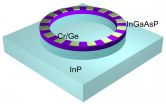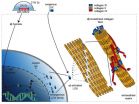INFORMATION:
The National Institutes of Health's Eunice Kennedy Shriver National Institute of Child Health and Human Development and Penn State's The Huck Institutes for the Life Sciences supported this research.
Researchers probe link between newborn health and vitamin A
2014-10-30
(Press-News.org) The impact vitamin A has on newborns is virtually unknown, but Penn State nutrition researchers have published two papers that may provide a framework for future investigations of the vitamin and neonatal health.
After supplementing newborn rats with vitamin A, the researchers found that vitamin A distribution within the body increases suddenly but temporarily, with a significant amount found in tissues other than the liver. Vitamin A in adults is usually found in significant amounts in the liver.
Nutrition experts know that vitamin A is necessary for prenatal growth and development, as well as in older children; but the role of vitamin A remains unclear for the neonatal period. Stores of the vitamin become depleted as the fetus reaches full term, to the point where newborns are nearly depleted of vitamin A. Neonates born in developing countries are likely to have even lower amounts of vitamin A in their bodies.
"The World Health Organization recommends periodic vitamin A supplements to children living in developing countries," said A. Catharine Ross, professor of nutritional sciences and Dorothy Foehr Huck Chair. "Giving large doses of vitamin A to children 6 months to 5 years old has shown to decrease mortality by 23 percent. However, studies in children under 6 months have been inconclusive."
Ross and colleagues studied levels of vitamin A in rat pups for two weeks, from 4 days old to 18 days old, similar to neonatal age in children. Half the pups received a vitamin A supplement while the others did not receive any supplement -- serving as the control.
The researchers measured the pups' rate of vitamin A metabolism by sampling various organs and found that vitamin A was used very quickly. Retinol, which is a form that vitamin A takes in the body, isn't broken down immediately and is recycled between plasma and tissues. The pups that received the supplement experienced lower rates of recycling, however they had greater uptake of vitamin A in extravascular tissues.
The supplemented rats were also found to have an increased uptake of chylomicron retinyl ester -- another form that vitamin A takes in the body -- in the lungs, intestines and remaining tissue, and a decrease in retinol turnover out of the liver, compared to the unsupplemented rats, Ross and colleagues report in two recent articles published in the Journal of Lipid Research.
The researchers speculate that since the neonates are born with a low vitamin A level but have a high demand for it, the uptake of retinyl ester in tissues other than the liver is an adaptive mechanism to make more vitamin A available for use.
"This research provides us with a blueprint for humans, giving us a baseline set of data, in order to let us make comparisons in the future," said Ross. "By being able to better understand infants' nutritional needs, evidence-based dietary intake recommendations could be made and infant mortality could potentially be reduced, particularly in developing countries."
Also working on this research were Libo Tan, graduate student and postdoctoral fellow in nutritional sciences; Amanda E. Wray, research technologist in nutritional sciences; and Michael H. Green, professor of nutritional sciences.
ELSE PRESS RELEASES FROM THIS DATE:
Could daylight saving time be a risk to diabetics?
2014-10-30
Soon, many will turn back the hands of time as part of the twice-annual ritual of daylight saving time. That means remembering to change the alarm clock next to the bed, which will mean an extra hour of sleep before getting up in the morning.
But for some diabetics who use insulin pumps, Saleh Aldasouqi, associate professor of medicine at Michigan State University, suggests that remembering to change the time on this device should be the priority.
"Some diabetes patients who use insulin pumps may forget to change the clock that is found in these devices," said diabetes ...
They know the drill: UW leads the league in boring through ice sheets
2014-10-30
MADISON, Wis. — Wisconsin is famous for its ice fishers — the stalwarts who drill holes through lake ice in the hope of catching a winter dinner. Less well known are the state's big-league ice drillers — specialists who design huge drills and use them to drill deep into ice in Greenland and Antarctica, places where even summer seems like winter.
The quarry at these drills includes some of the biggest catches in science.
A hot-water drill designed and built at the University of Wisconsin-Madison's Space Science and Engineering Center (SSEC) and the ...
New optimal screening threshold for gestational diabetes in twin pregnancies
2014-10-30
Philadelphia, PA, October 30, 2014 – A common complication, gestational diabetes affects approximately 6-7% of pregnant women. Currently, screening is done in two steps to help identify patients most at risk; however, the suggested levels for additional testing were based on singleton pregnancy data. Now investigators have analyzed data from twin pregnancies and have determined that the optimal first step cutoff for additional screening appears to be a blood sugar level equal to or greater than 135 mg/dL for women carrying twins. Their findings are published in the ...
For stroke patients, hospital bed position is delicate balancing act
2014-10-30
MAYWOOD, Ill. (Date) – During the first 24 hours after a stroke, attention to detail --such as hospital bed positioning -- is critical to patient outcomes.
Most strokes are caused by blood clots that block blood flow to the brain. Sitting upright can harm the patient because it decreases blood flow and oxygen to the brain just when the brain needs more blood.
Thus, it's reasonable to keep patients lying flat or as nearly flat as possible, according to a report in the journal MedLink Neurology by Loyola University Medical Center neurologist Murray Flaster, MD, ...
Biology meets geometry
2014-10-30
(Santa Barbara, Calif.) — Architecture imitates life, at least when it comes to those spiral ramps in multistory parking garages. Stacked and connecting parallel levels, the ramps are replications of helical structures found in a ubiquitous membrane structure in the cells of the body.
Dubbed Terasaki ramps after their discoverer, they reside in an organelle called the endoplasmic reticulum (ER), a network of membranes found throughout the cell and connected to and surrounding the cell nucleus. Now, a trio of scientists, including UC Santa Barbara biological physicist ...
Heart's own immune cells can help it heal
2014-10-30
The heart holds its own pool of immune cells capable of helping it heal after injury, according to new research in mice at Washington University School of Medicine in St. Louis.
Most of the time when the heart is injured, these beneficial immune cells are supplanted by immune cells from the bone marrow, which are spurred to converge in the heart and cause inflammation that leads to further damage. In both cases, these immune cells are called macrophages, whether they reside in the heart or arrive from the bone marrow. Although they share a name, where they originate appears ...
Study shows vibrating insoles could reduce falls among seniors
2014-10-30
BOSTON — Findings published in the Archives of Physical Medicine and Rehabilitation show that imperceptible vibratory stimulation applied to the soles of the feet improved balance by reducing postural sway and gait variability in elderly study participants. The vibratory stimulation is delivered by a urethane foam insole with embedded piezoelectric actuators, which generates the mechanical stimulation. The study was conducted by researchers from the Institute for Aging Research (IFAR) at Hebrew SeniorLife, Beth Israel Deaconess Medical Center, the Wyss Institute for ...
Lord of the microrings
2014-10-30
A significant breakthrough in laser technology has been reported by the U.S. Department of Energy (DOE)'s Lawrence Berkeley National Laboratory (Berkeley Lab) and the University of California (UC) Berkeley. Scientists led by Xiang Zhang, a physicist with joint appointments at Berkeley Lab and UC Berkeley, have developed a unique microring laser cavity that can produce single-mode lasing even from a conventional multi-mode laser cavity. This ability to provide single-mode lasing on demand holds ramifications for a wide range of applications including optical metrology and ...
Making lab-grown tissues stronger
2014-10-30
Lab-grown tissues could one day provide new treatments for injuries and damage to the joints, including articular cartilage, tendons and ligaments.
Cartilage, for example, is a hard material that caps the ends of bones and allows joints to work smoothly. UC Davis biomedical engineers, exploring ways to toughen up engineered cartilage and keep natural tissues strong outside the body, report new developments this week in the journal Proceedings of the National Academy of Sciences.
"The problem with engineered tissue is that the mechanical properties are far from those ...
Experts recommend tumor removal as first-line treatment for acromegaly
2014-10-30
Washington, DC—The Endocrine Society today issued a Clinical Practice Guideline (CPG) for the diagnosis and treatment of acromegaly, a rare condition caused by excess growth hormone in the blood.
The CPG, entitled "Acromegaly: An Endocrine Society Clinical Practice Guideline," appeared in the November 2014 issue of the Journal of Clinical Endocrinology and Metabolism (JCEM), a publication of the Endocrine Society.
Acromegaly is usually caused by a non-cancerous tumor in the pituitary gland. The tumor manufactures too much growth hormone and spurs the body to overproduce ...




